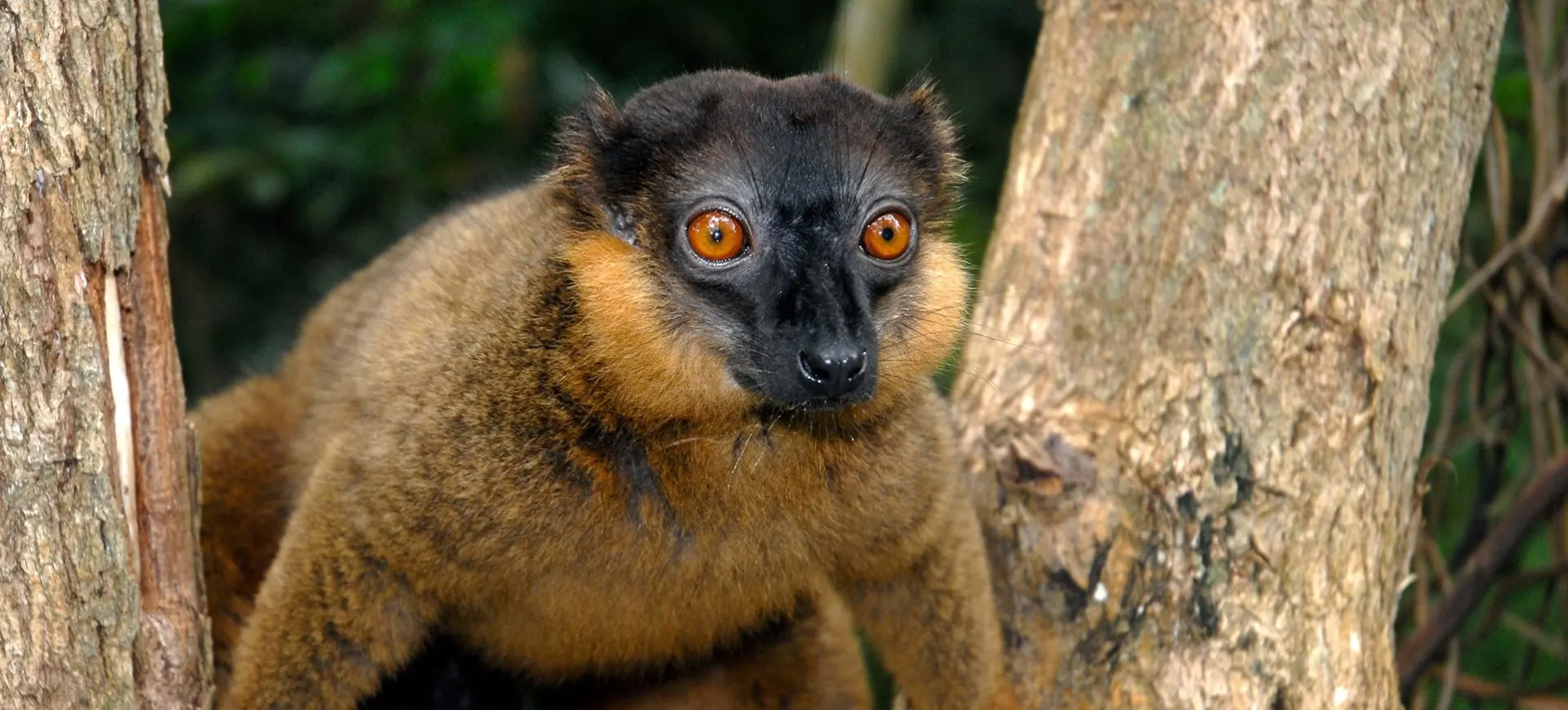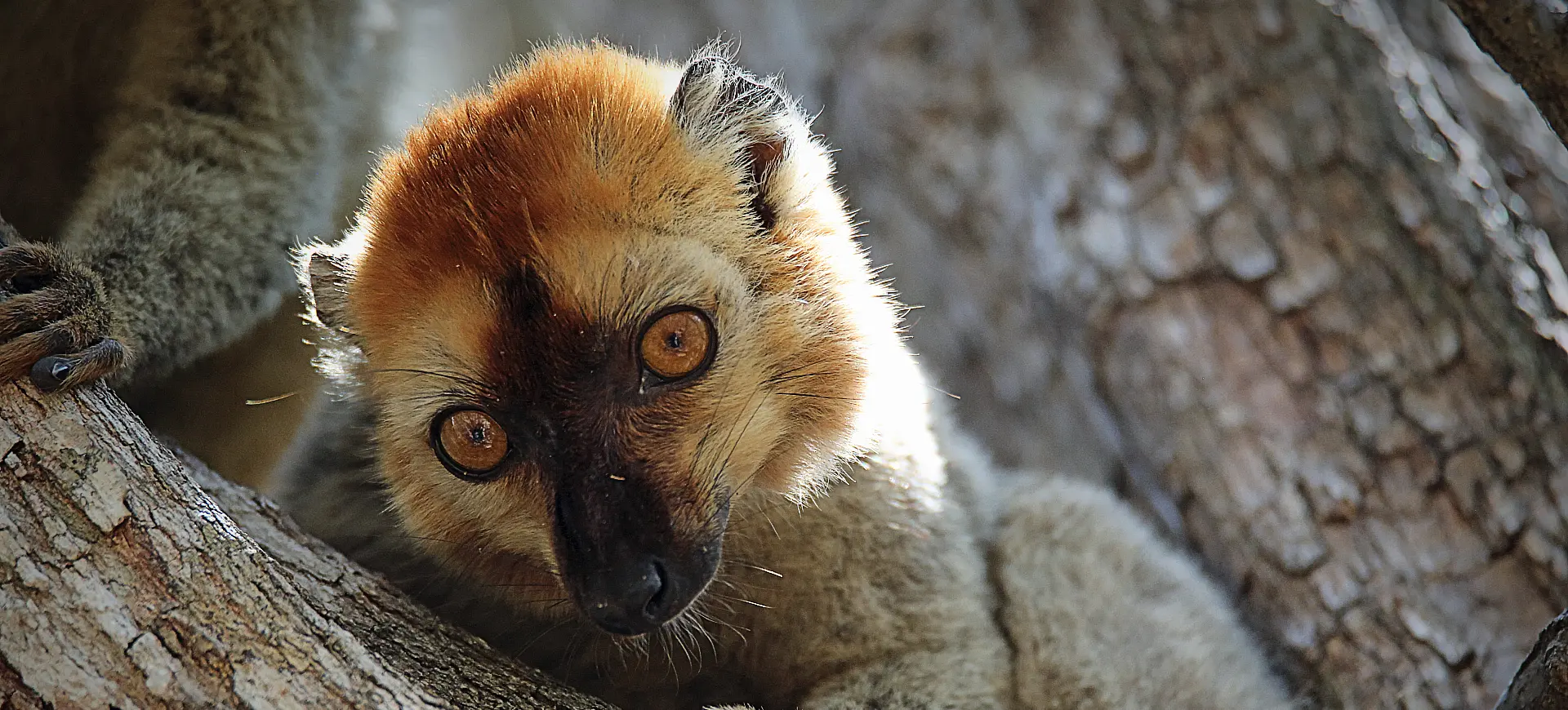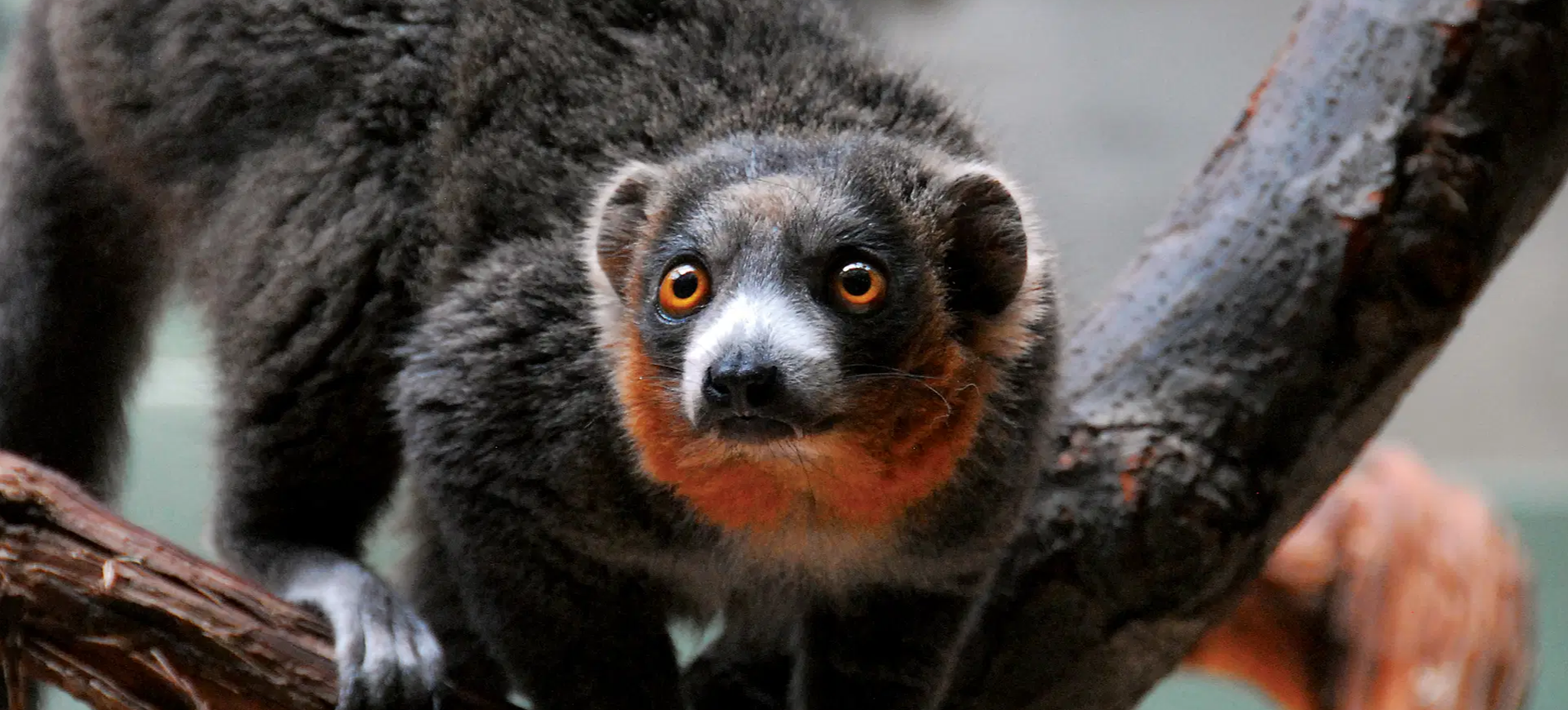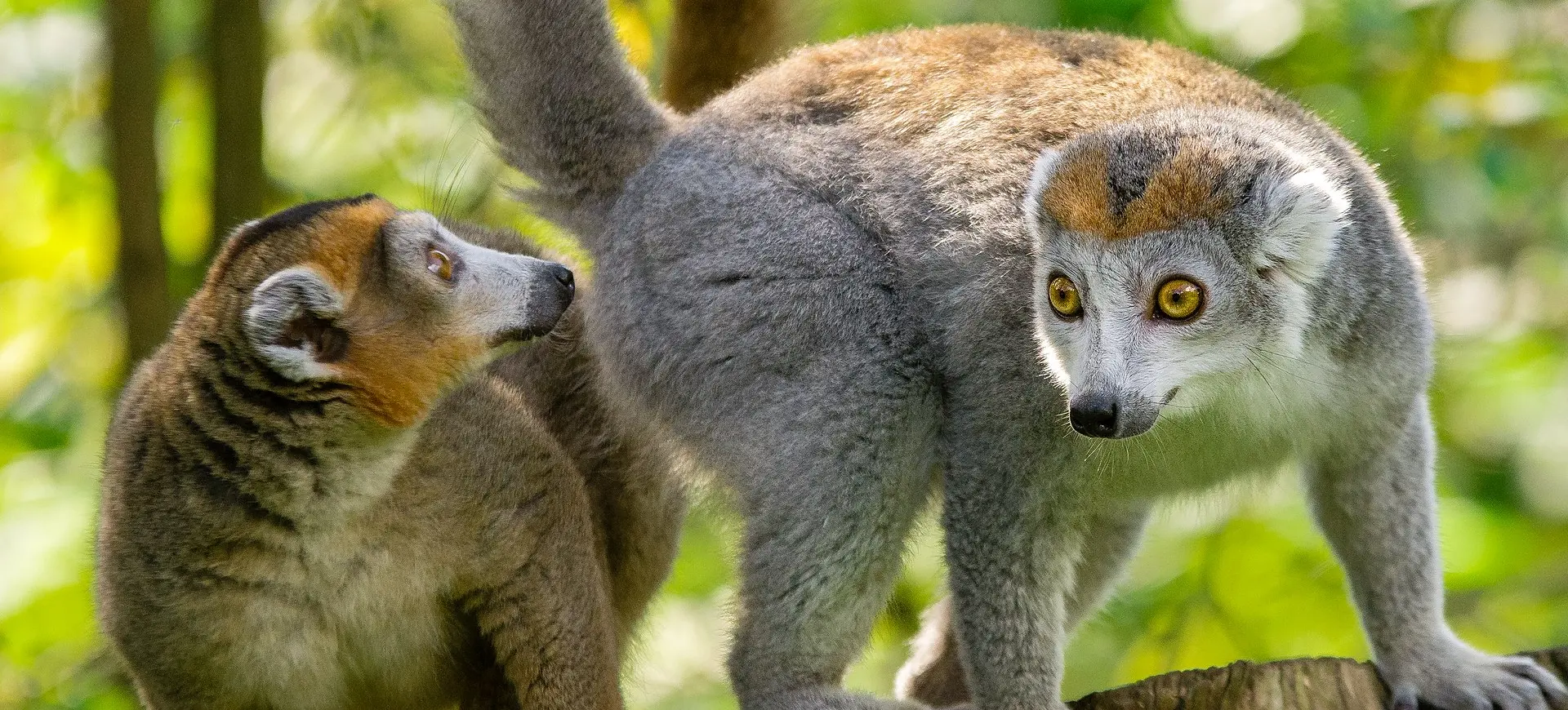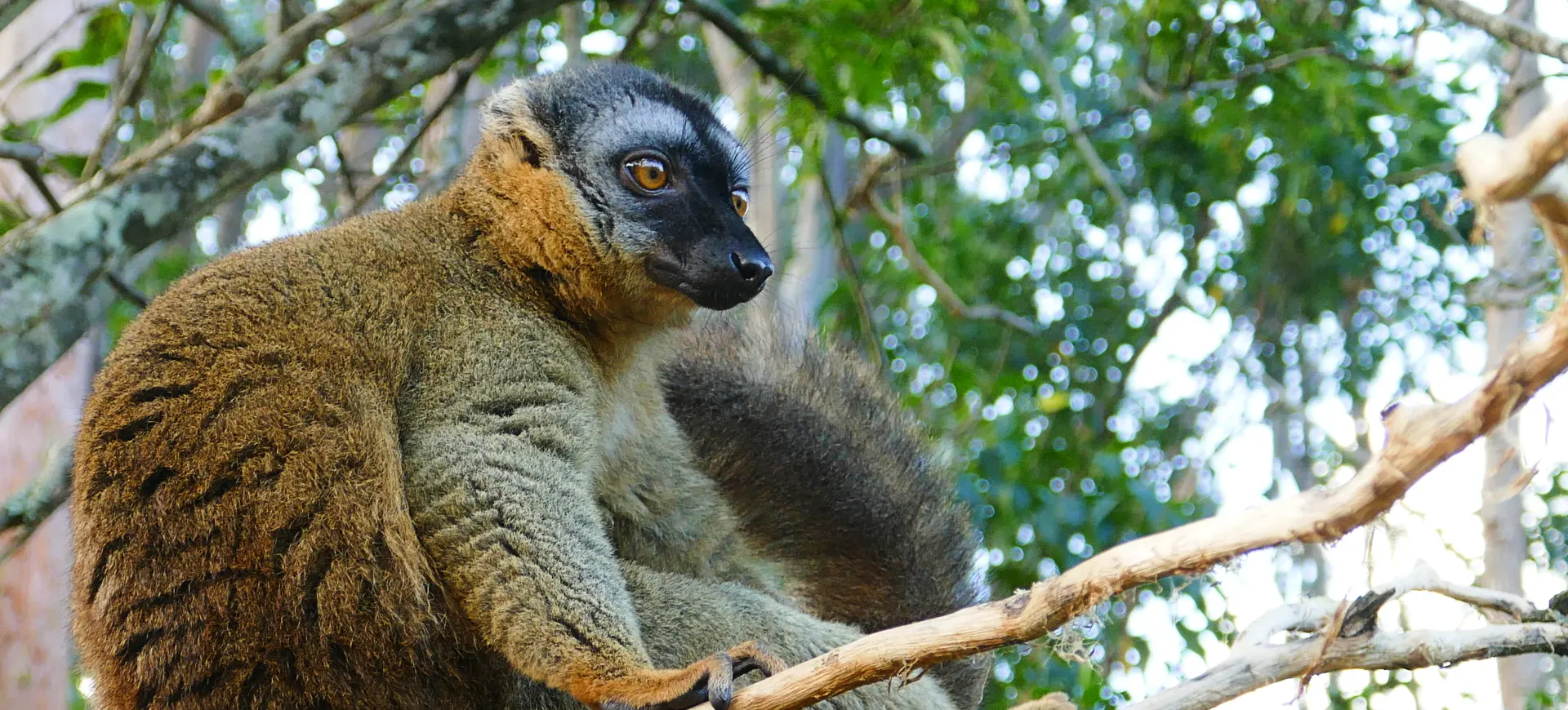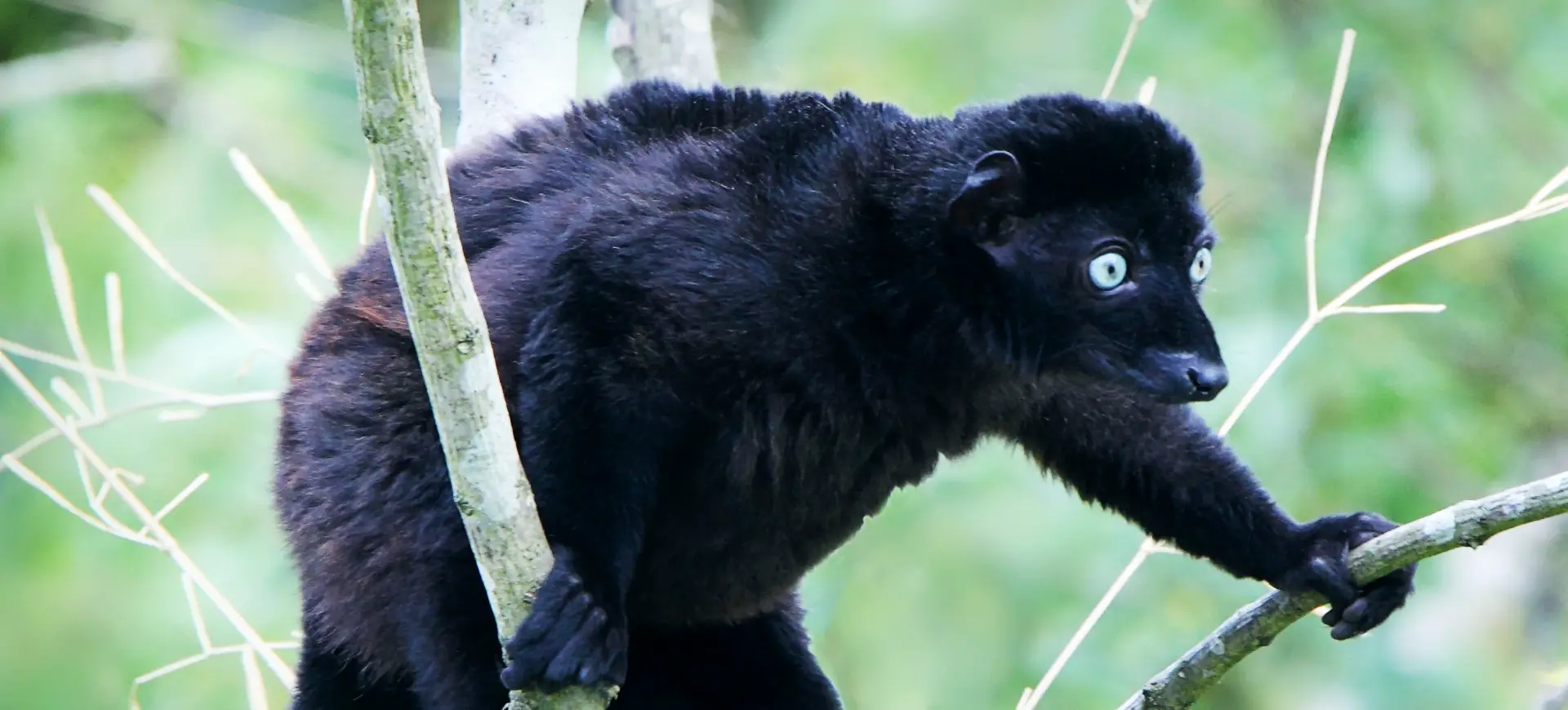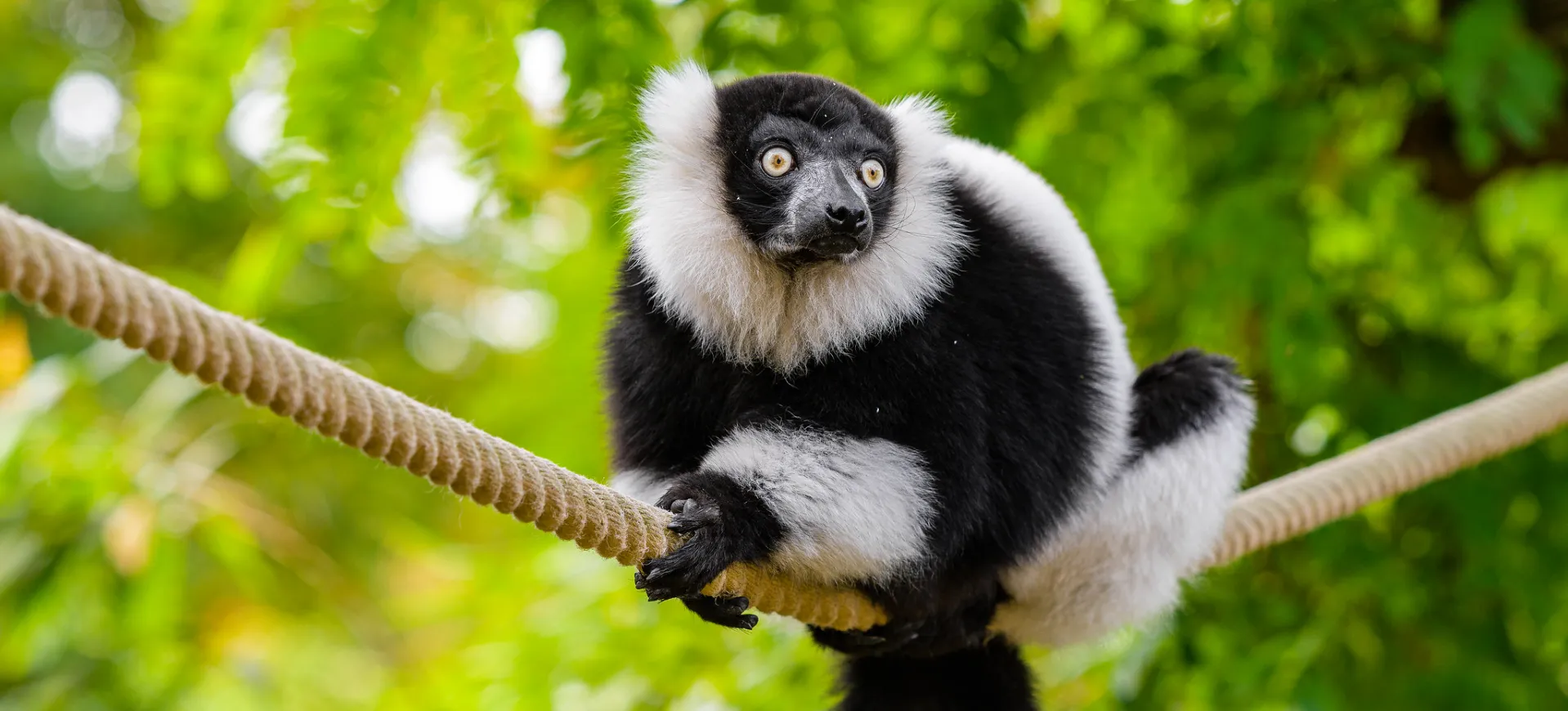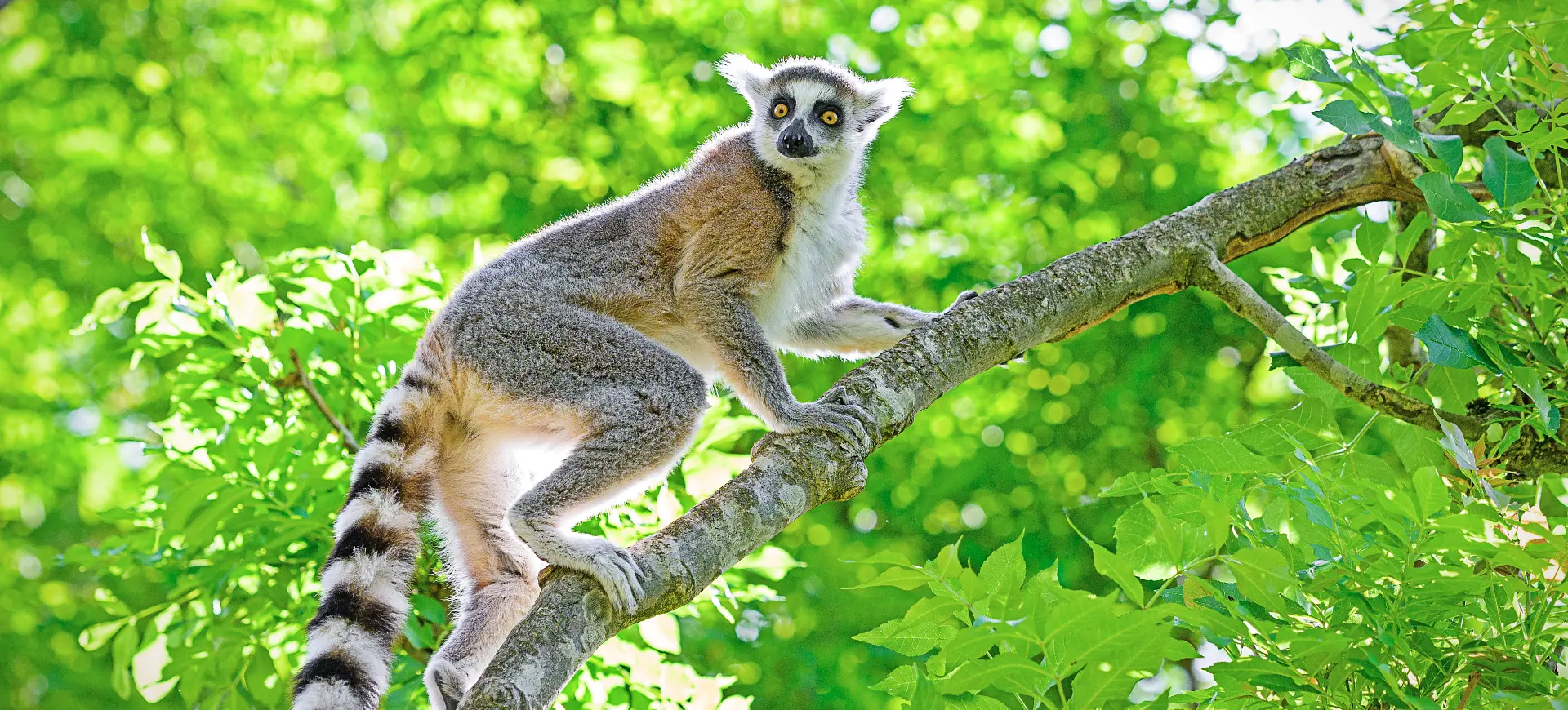Overview
The Red Ruffed Lemur (Varecia rubra) is a striking species of lemur known for its vibrant red and black fur, a distinctive feature that sets it apart from other lemurs. Endemic to Madagascar, specifically the rainforests of Masoala, this species plays a crucial role in its ecosystem, primarily through seed dispersal. These animals are diurnal and arboreal, spending most of their time in the high canopy of the forest, where they forage for fruits, nectar, and leaves. Socially, Red Ruffed Lemurs live in small, matriarchal groups, communicating through a complex system of vocalizations to maintain group cohesion and territory.
Red Ruffed Lemurs exhibit a high degree of sexual dimorphism, with females often being slightly larger than males. This species is known for its large, piercing eyes, which enhance its vision in the low light conditions of the forest understory. Their long, bushy tails, which can be as long as their bodies, help them balance while navigating the treetops. Despite their beauty and ecological importance, Red Ruffed Lemurs face significant threats from habitat destruction and hunting, making conservation efforts critical for survival.
The reproductive behavior of Red Ruffed Lemurs is unique among primates. They have one of the shortest gestation periods, resulting in the birth of relatively undeveloped offspring, which they leave in leafy nests while foraging. This reproductive strategy, combined with their seasonal breeding patterns, is closely tied to the ecological rhythms of their forest habitat. Conservationists emphasize the importance of protecting the natural habitats of Red Ruffed Lemurs, not only for the species’ survival but also for maintaining the ecological balance in Madagascar’s rainforests.
Physical Description:
Red Ruffed Lemurs are notable for their striking appearance, characterized by their deep red fur and contrasting patches of black on their limbs, tails, and faces. Adult males and females typically display similar color patterns, making them difficult to distinguish based solely on coloration. They have a distinctive ruff of long fur around their necks, which can be fluffed up as a display or appear larger to predators or rivals. Their hands and feet are adapted for gripping tree branches, with long, nimble fingers and toes that enable them to traverse the canopy swiftly.
These lemurs have a body length ranging from 20 to 22 inches (50 to 55 cm), excluding the tail, which can add 24 inches (60 cm) to their length. They weigh between 7.7 to 9.9 pounds (3.5 to 4.5 kg), with slight variations between males and females. Their large, forward-facing eyes provide excellent depth perception, crucial for navigating the complex forest environment. Besides serving as a balance tool, the tail is also used for communication, waving it to signal other lemurs during social interactions or when threatened.

Lifespan: Wild: ~15 || Captivity: ~20 years

Weight: Male & Female: 7.7 - 9.9 lbs (3.5 - 4.5 kg)

Length: Male & Female: 20 - 22 inches (50 - 55 cm) || Tail: 24 - 26 inches (60 - 66 cm)

Top Speed: 15 mph (24 km/h)
Characteristic:
Native Habitat:
The Red Ruffed Lemur is native exclusively to the northeastern rainforests of Madagascar, particularly the Masoala Peninsula. This area is characterized by dense, wet forests that provide the high canopy and diverse fruiting trees necessary for their arboreal lifestyle. The climate is tropical, with significant rainfall distributed throughout the year, supporting the lush, biodiverse habitat these lemurs require. The complex forest structure offers food, nesting sites, and protection from predators.
Their habitat preferences are tightly linked to the availability of fruiting trees and dense canopy cover for movement and nesting. Red Ruffed Lemurs are highly dependent on large tracts of uninterrupted forest, making them particularly vulnerable to deforestation and habitat fragmentation. The species’ range is limited to specific regions within the Masoala Peninsula, making their habitat highly valuable for conservation efforts. Efforts to protect and restore their natural habitat are crucial for the survival of this species, emphasizing the importance of protected areas and reforestation projects in Madagascar.
Climate Zones:
Biomes:
WWF Biomes:
Biogeographical Realms:
Continents:
Countries:
Diet:
Diet & Feeding Habits:
Red Ruffed Lemurs are primarily frugivorous, relying heavily on various fruits for their diet, supplemented by leaves, nectar, and seeds. Their feeding habits are crucial to their ecosystem, as they are vital seed dispersers for many tree species. They possess specialized teeth for piercing fruit skins and a long snout and tongue for accessing nectar, adaptations that facilitate their specialized diet. During seasons when fruits are less abundant, they will also consume leaves and other available vegetation, showing some flexibility in their diet to cope with varying food availability.
Foraging behavior in Red Ruffed Lemurs is highly social. It can be noisy, as individuals communicate with each other about sounds to coordinate their movements and alert each other to food sources. They prefer feeding in the upper canopy, where their preferred food sources are most abundant. These lemurs are also known to occasionally consume soil, a behavior thought to supplement their diet with minerals or help detoxify some of the secondary compounds in their primarily fruit-based diet. Their feeding patterns are closely linked to the seasonal availability of fruits, leading to seasonal migrations within their habitat to follow the ripening schedules of different fruit trees.
Mating Behavior:
Mating Description:
Red Ruffed Lemurs have a unique mating system characterized by seasonal breeding, usually coinciding with the onset of the rainy season when food resources are most abundant. Females are highly selective, choosing mates based on their physical condition and displays of strength and agility. Mating typically occurs in the trees and can involve multiple males competing for access to a receptive female. After mating, females construct nests out of leaves and branches, where they will give birth and care for their young.
The gestation period for Red Ruffed Lemurs is approximately 102 days, after which females give birth to a litter of two to six offspring. These infants are born relatively undeveloped and are left in the nest while the mother forages, returning regularly to nurse them. This nesting behavior is unique among primates and allows mothers to conceal their vulnerable offspring. As the offspring grow, they become more active and accompany their mothers on foraging trips, learning to navigate the complex forest environment.
Reproduction Season:
Birth Type:
Pregnancy Duration:
Female Name:
Male Name:
Baby Name:
Social Structure Description:
Red Ruffed Lemurs exhibit a complex social structure characterized by matriarchal groups, where females often hold a higher status than males. These groups are typically small, consisting of close family members, and are highly territorial. Vocal communication plays a significant role in maintaining group cohesion and territory boundaries, with individuals using a variety of calls to communicate with each other. Social grooming is an important bonding activity, strengthening social ties within the group.
Despite their social nature, Red Ruffed Lemurs also display a degree of independence, especially when foraging. They may forage alone or in small, temporary groups, coming together again to rest or share larger food finds. This flexibility in social organization allows them to adapt to the varying availability of food resources in their environment. Understanding the social dynamics of red ruffed lemurs is crucial for conservation efforts, particularly in designing protected areas and reintroducing programs that support their natural behaviors.
Groups:
Conservation Status:
Population Trend:
The wild population of Red Ruffed Lemurs has experienced a significant decline over the past few decades, primarily due to habitat loss, hunting, and the illegal pet trade. These factors have contributed to their status as Critically Endangered, with fragmented populations facing ongoing threats. Efforts to accurately count and monitor wild populations are challenging due to the lemurs’ arboreal nature and the inaccessibility of their rainforest habitat. However, ongoing research and conservation efforts aim to gather more accurate population data to inform protection strategies.
Red Ruffed Lemurs have been part of successful breeding programs in captivity, contributing to a better understanding of their reproductive biology and social behavior. Zoos and conservation centers play a vital role in educating the public about the plight of these lemurs and the importance of conserving their natural habitats. Captive populations also serve as an important genetic reservoir for potential reintroduction programs in the future, offering hope for bolstering wild populations and ensuring the species’ survival.
Population Threats:
Red Ruffed Lemurs’ primary threat is habitat destruction due to slash-and-burn agriculture, illegal logging, and mining. These activities fragment their forest habitat, isolating populations and reducing their access to food and mates. Hunting for bushmeat and capture for the illegal pet trade also pose significant risks despite legal protections. The impact of climate change, particularly changes in rainfall patterns, further threatens their habitat by affecting the availability of food resources and nesting sites.
Disease transmission from domestic animals and humans is an emerging threat, particularly in areas where human populations encroach on lemur habitats. Efforts to mitigate these threats require comprehensive strategies, including habitat protection, law enforcement, and community engagement, to promote sustainable practices. Addressing the root causes of habitat destruction and hunting is essential for the long-term conservation of Red Ruffed Lemurs.
Conservation Efforts:
Conservation efforts for Red Ruffed Lemurs include habitat protection, reforestation projects, and establishing protected areas within their native range. An international collaboration between conservation organizations, local communities, and the Malagasy government aims to enforce laws against hunting and habitat destruction. Education and outreach programs are crucial for raising awareness about the importance of these lemurs and the threats they face, encouraging local and global support for conservation efforts.
Captive breeding programs and research initiatives contribute to understanding Red Ruffed Lemurs’ needs and behaviors and informing conservation strategies. Efforts to create ecological corridors to connect fragmented habitats are underway to increase genetic diversity and population resilience. These multifaceted conservation strategies are critical for reversing the decline of Red Ruffed Lemurs and ensuring their survival for future generations.
Additional Resources:
Fun Facts
- Red Ruffed Lemurs have a complex vocal communication system, capable of making over a dozen different sounds.
- They are one of the few primate species that use leaves and branches to build nests for their offspring.
- This species has a highly specialized diet, primarily feeding on fruit, which makes them important seed dispersers in their ecosystem.
- Red Ruffed Lemurs can hang upside down from their feet to feed, using their nimble hands to manipulate food.
- They can make leaps over 25 feet (7.6 meters) between trees in the forest canopy.
- Infants are born with their eyes open and are among the primates’ most altricial (underdeveloped) at birth.
- Unlike many primates, Red Ruffed Lemurs have a keen sense of smell, which they use to communicate and locate food.
- They are one of Madagascar’s largest lemurs, with their bright red and black fur making them one of the most visually distinctive.
- The species plays a crucial role in their ecosystem, acting as a keystone species for seed dispersal.
- Red ruffed lemurs focus on the lemurs themselves and preserving the rich biodiversity of Madagascar’s rainforests.





